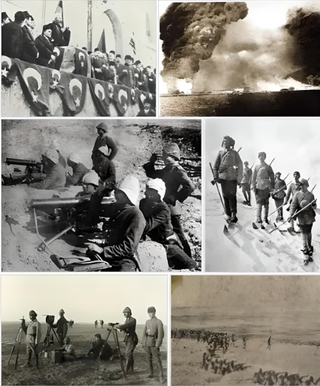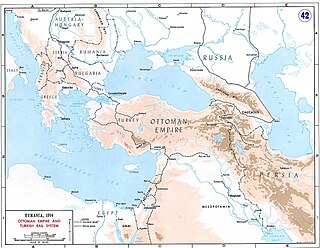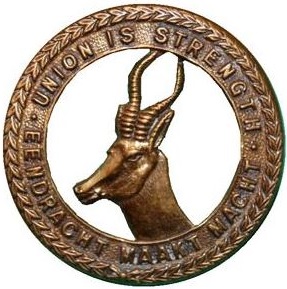
Coolie is a pejorative term used for low-wage labourers, typically those of Indian or Chinese descent.

The Mesopotamian campaign or Mesopotamian front was a campaign in the Middle Eastern theatre of World War I fought between the Allies represented by the British Empire, troops from Britain, Australia and the vast majority from British Raj, against the Central Powers, mostly the Ottoman Empire. It started after British amphibious landings in 1914 which sought to protect Anglo-Persian oil fields in Khuzestan and the Shatt al-Arab. However, the front later evolved into a larger campaign that sought to capture the key city of Baghdad and divert Ottoman forces from other fronts. It ended with the Armistice of Mudros in 1918, leading to the cession of Iraq and further partition of the Ottoman Empire.

The fall of Baghdad occurred during the Mesopotamian campaign, fought between the forces of the British Empire and the Ottoman Empire in World War I.

The Middle Eastern theatre of World War I saw action between 30 October 1914 and 30 October 1918. The combatants were, on one side, the Ottoman Empire, with some assistance from the other Central Powers; and on the other side, the British as well as troops from the British Dominions of Australia, Canada, and New Zealand, the Russians, and the French from among the Allied Powers. There were five main campaigns: the Sinai and Palestine, Mesopotamian, Caucasus, Persian, and Gallipoli campaigns.

Dunsterforce was an Allied military force, established in December 1917 and named after its commander, Major-General Lionel Dunsterville. The force comprised fewer than 350 Australian, New Zealand, British and Canadian officers and NCOs, who were drawn from the Western and Mesopotamian fronts. The force was intended to organise local units in northern Iran (Persia) and South Caucasus, to replace the Tsarist army that had fought the Ottoman armies in Armenia. The Russians had also occupied northern Iran in co-operation with the British occupation of southern Iran, to create a cordon to prevent German and Ottoman agents from reaching Central Asia, Afghanistan and India.

The South African Overseas Expeditionary Force (SAOEF) was a volunteer military organisation in World War I.

The Persian campaign or invasion of Iran was a series of military conflicts between the Ottoman Empire, British Empire and Russian Empire in various areas of what was then neutral Qajar Iran, beginning in December 1914 and ending with the Armistice of Mudros on 30 October 1918, as part of the Middle Eastern Theatre of World War I. The fighting also involved local Persian units, who fought against the Entente and Ottoman forces in Iran. The conflict proved to be a devastating experience for Persia. Over 2 million Persian civilians died in the conflict, mostly due to the Armenian genocide by the Ottoman regime and Persian famine of 1917–1919, influenced by British and Russian actions. The Qajar government's inability to maintain the country's sovereignty during and immediately after the First World War led to a coup d'état in 1921 and Reza Shah's establishment of the Pahlavi dynasty.

The Indian Army, also called the British Indian Army, was involved in World War I as part of the British Empire. More than one million Indian troops served overseas, of whom more than 60,000 died during the war.

The 14th Murray's Jat Lancers, also sometimes known as the Murray's Jat Horse, was a cavalry regiment of the British Indian Army. In 1921 it was renamed as 20th Lancers, and after Partition of India in 1947 it eventually became 20 Lancers (India) as an armoured regiment of the Indian Army. Its muslim soldiers were retained in the regiment which is now known as the 20th Lancers (Pakistan).

Madras Engineer Group (MEG), informally known as the Madras Sappers, is an engineer group of the Corps of Engineers of the Indian Army. The Madras Sappers draw their origin from the erstwhile Madras Presidency army of the British Raj. This regiment has its HQ in Bengaluru. The Madras Sappers are the oldest of the three groups of the Corps of Engineers.

The Chinese Labour Corps was a labour corps recruited by the British government in the First World War to free troops for front line duty by performing support work and manual labour. The French government also recruited a significant number of Chinese labourers, and although those labourers working for the French were recruited separately and not part of the CLC, the term is often used to encompass both groups. In all, some 140,000 men served for both British and French forces before the war ended and most of the men were repatriated to China between 1918 and 1920.

Wang Jungzhi was a Chinese labourer, who was one of the last people to be executed by the British Army during the First World War. He was convicted of murder and executed by firing squad on 8 May 1919, six months after the Armistice.

The 106th Hazara Pioneers was a pioneer infantry regiment of the British Indian Army. They were formed in 1904 at Quetta from Hazara people. They were disbanded in 1933.
The Egyptian Labour Corps was a group of Egyptian labourers who worked for the British Army in Egypt during the First World War's Sinai and Palestine Campaign.

The South African Native Labour Corps (SANLC) was a force of workers formed in 1916 in response to a British request for workers at French ports. About 25,000 South Africans joined the Corps. The SANLC was utilized in various menial noncombat tasks. The SANLC was disbanded by the South African government in January 1918.
The 36th Indian Brigade was an infantry brigade of the British Indian Army that saw active service with the Indian Army during the First World War. It took part in the Mesopotamian campaign and later formed part of the North Persia Force. It remained with the Force until withdrawn in June 1921.
The Battle of Mount Hamrin was an unsuccessful British effort to cut off part of the Ottoman Sixth Army after the capture of Baghdad during the Mesopotamia campaign during the First World War.

China participated in World War I from 1917 to 1918 in an alliance with the Entente Powers. Although China never sent troops overseas, 140,000 Chinese labourers served for both British and French forces before the end of the war. While neutral since 1914, Duan Qirui, Premier of the Republic of China, spearheaded Chinese involvement in World War I. Tuan wanted to integrate China with Europe and the United States by declaring on the side of the Allies against the Central Powers. On 14 August 1917, China ended its neutrality, declaring war on the German Empire and the Austro-Hungarian Empire.

The British colony of Hong Kong saw no military action during World War I (1914–1918). The biggest external threat to the colony was perceived to be the German East Asia Squadron, but the squadron was eliminated in December 1914. Nonetheless, the colony served as an important port in East Asia, including as the headquarters of the British China Station, and saw significant socioeconomical changes during the war.

The Fijian Labour Corps was a labour corps unit raised in Fiji that served alongside British Empire forces in the First and Second World Wars. The unit was first formed in 1917 at the proposal of Lala Sukuna, the son of a Fijian chief who had been rejected for service in the British Army on account of his race. The 101-strong unit initially served to support the Western Front providing labour at Calais and Marseilles and worked in Taranto, Italy, after the end of the war. The unit completed its service in 1919 and returned to Fiji. Twelve members of the unit died during the war.

















